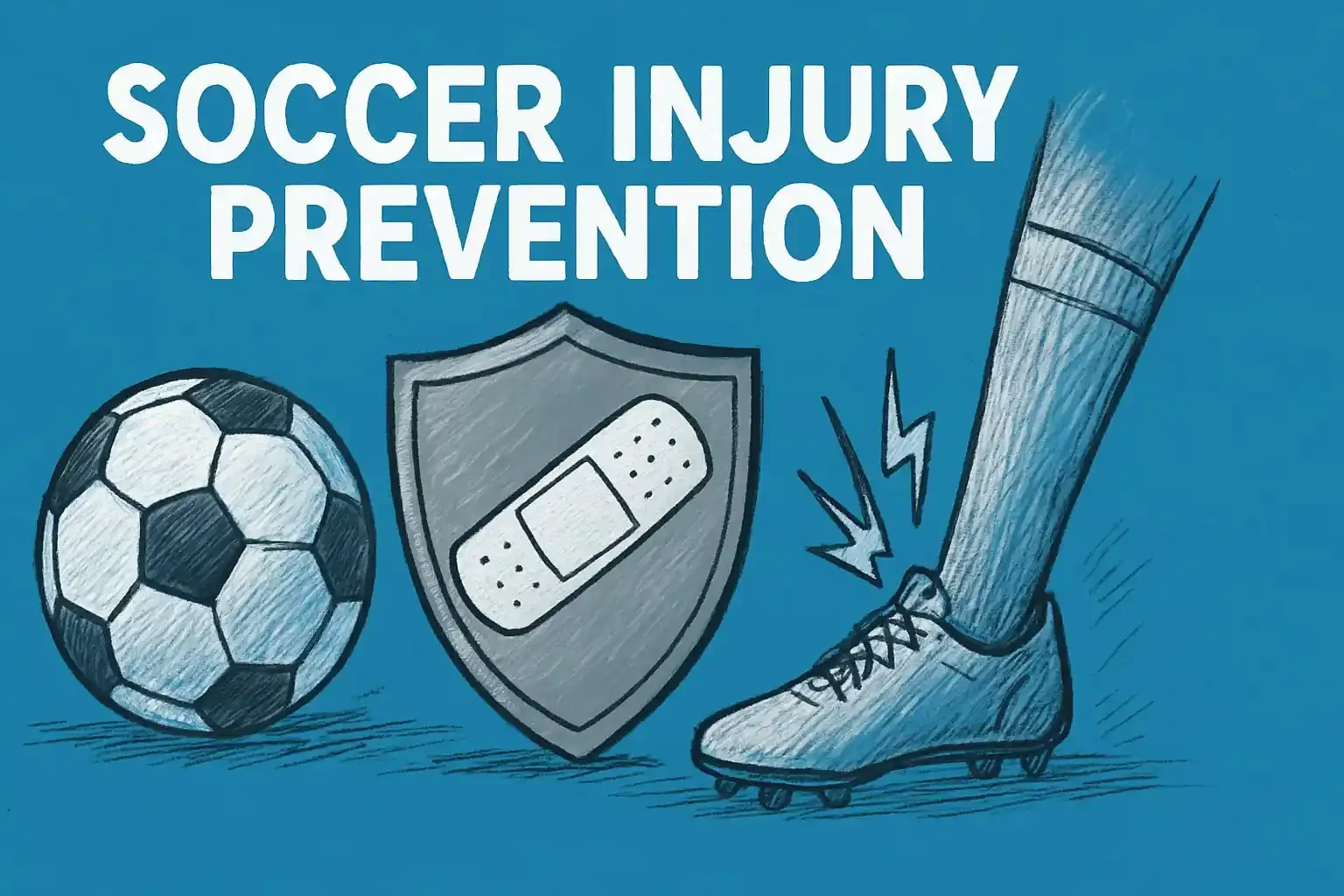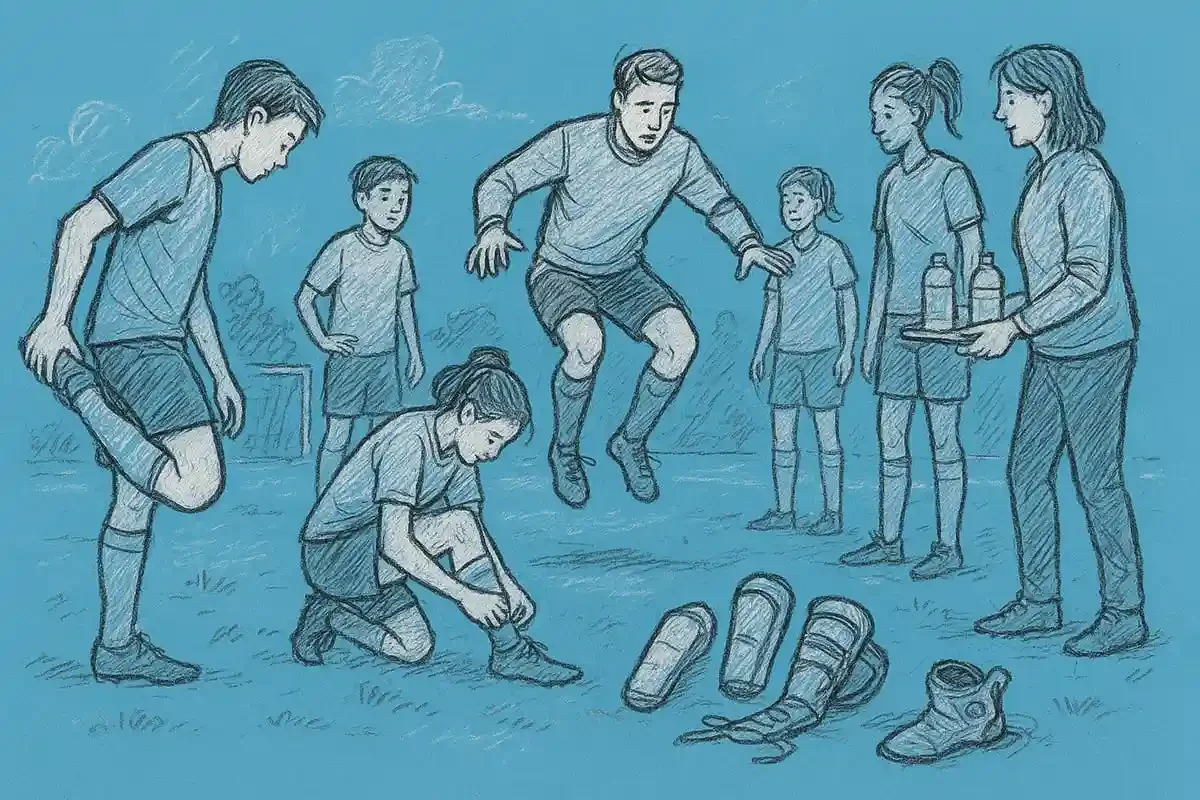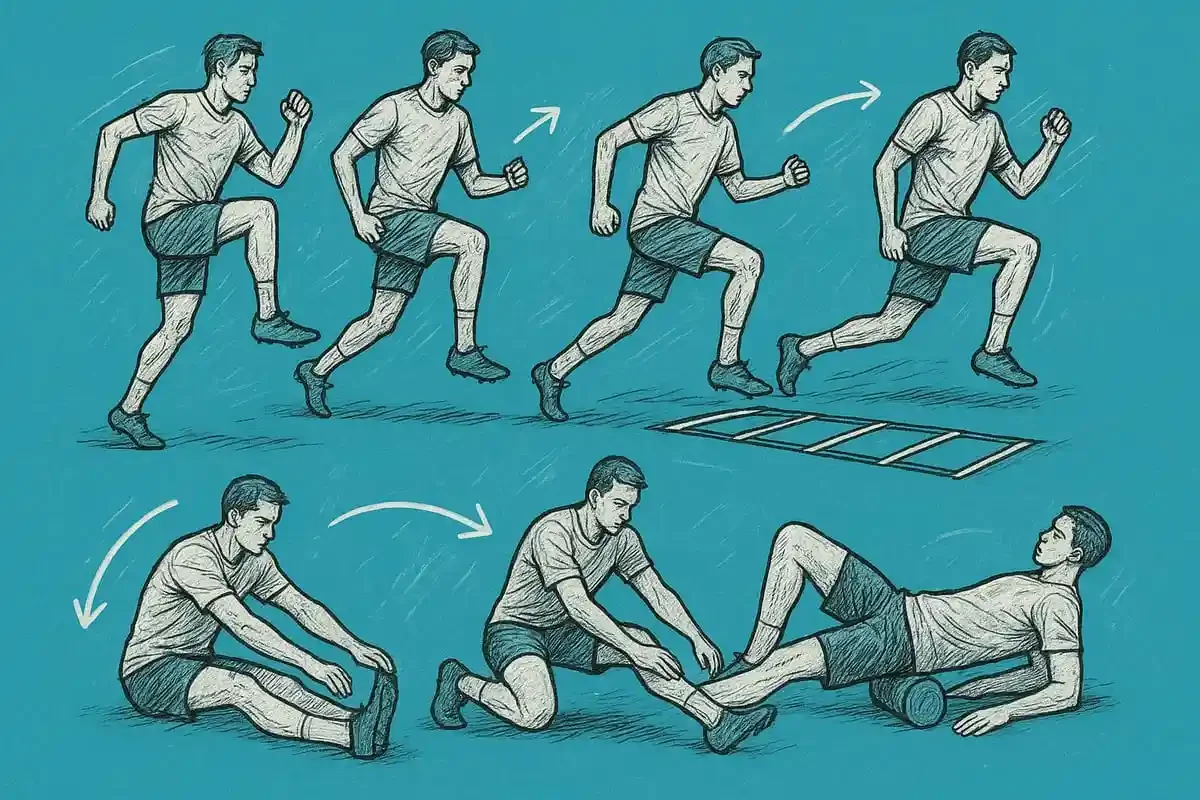Soccer Injury Prevention Guide: Staying Safe in Todays Game
Every year, thousands of soccer players face injuries that sideline their dreams and disrupt team success. In fact, recent studies reveal that many of these injuries could have been prevented with the right soccer injury prevention strategies and preparation.
This guide is your up-to-date roadmap for 2025, giving players, coaches, and parents the tools they need to keep the game safe. Inside, you will discover the latest injury trends, learn about key risk factors, explore proven prevention methods, and find essential warm-up routines. Let’s work together to make soccer safer and more enjoyable for everyone.
Understanding Soccer Injuries in 2025
Every soccer season, players at all levels face a range of injuries, many of which can be minimized with the right approach to soccer injury prevention. Knowing what types of injuries are most common, how trends are evolving, and what factors increase risk is the first step toward safer play for everyone involved.
Common Types of Soccer Injuries
Soccer injury prevention starts with knowing what you are up against. The most frequent injuries in the sport include sprains and strains, particularly to the ankle, knee, and hamstring. Overuse injuries like tendinitis and stress fractures are also prevalent, often developing from repetitive motion or inadequate rest.
Impact injuries, such as contusions and concussions, can result from player collisions or falls. It is important to distinguish between acute injuries, which happen suddenly, and chronic injuries that build up over time. According to a 2023 FIFA report, ankle sprains alone make up 20% of all soccer injuries, underlining the need for targeted prevention.
Here is a quick comparison of common soccer injuries:
Injury Type / Body Area / Frequency (%) / Acute or Chronic
Ankle Sprain / Ankle / 20 / Acute
Hamstring Strain / Hamstring / 14 / Acute
Tendinitis / Knee/Achilles / 12 / Chronic
Concussion / Head / 7 / Acute
Stress Fracture / Foot/Leg / 5 / Chronic
Understanding these patterns is vital for effective soccer injury prevention.
Injury Trends and Emerging Risks
Recent years have seen notable shifts in soccer injury prevention strategies, driven by changes in how the game is played. Injury rates among youth players have climbed, partly due to increased participation and the trend toward year-round competition. Artificial turf, now common in many venues, has been linked to higher rates of certain injuries compared to natural grass.
Early specialization, where young athletes focus on soccer exclusively, can raise the risk of both overuse and acute injuries. New rules and advances in equipment may change injury patterns, but do not eliminate the need for vigilance. Some data in recent years have demonstrated an increase in ACL injuries amongst female players, highlighting the importance of ongoing soccer injury prevention efforts.
Coaches and parents must stay informed about these trends to adapt their approach.
Factors Contributing to Soccer Injuries
Several factors make players more susceptible to injury, making soccer injury prevention a team effort. Inadequate warm-up or cool-down routines can leave muscles unprepared for intense activity. Poor technique, especially during tackles or jumps, increases the risk of strains and sprains.
Fatigue and overtraining are major contributors, as tired muscles lose coordination and strength. Wearing the wrong gear, such as ill-fitting shoes or missing shin guards, also raises injury risk. Environmental conditions, including weather, playing surface, and lighting, can tip the balance between safe play and injury.
By recognizing these factors, everyone involved can take steps to reduce risk and make soccer injury prevention an integral part of the game.
Key Principles of Soccer Injury Prevention
Soccer injury prevention is a layered process, relying on science-backed strategies and everyday habits. By understanding and applying these principles, players, coaches, and parents can make the sport safer for everyone.
The Role of Strength and Conditioning
Strength and conditioning form the foundation of soccer injury prevention. Balanced muscles, flexibility, and a strong core help players withstand the physical demands of the game.
Focus on exercises like squats, lunges, planks, and resistance band drills. Neuromuscular training, which improves coordination and joint stability, is especially effective. In fact, a 2023 meta-analysis found a 40 percent reduction in lower limb injuries when players followed structured strength routines.
Building these habits early ensures players can handle rapid changes in direction and speed, making soccer injury prevention a daily reality.
Proper Technique and Skill Development
Mastering safe movement patterns is vital for soccer injury prevention. Teaching athletes how to tackle, jump, and land safely reduces risk on the field.
Programs like FIFA 11+ have been proven to lower injury rates by focusing on body awareness and proprioception. According to a systematic review, the FIFA 11+ injury prevention program effectiveness is clear, showing a significant reduction in injuries when the protocol is followed.
Regular skill sessions and video feedback help reinforce these techniques, making soccer injury prevention part of every training session.
Load Management and Rest
Managing training loads is crucial for soccer injury prevention. Sudden spikes in intensity or volume can overwhelm the body, leading to overuse injuries and burnout.
Use simple tools like training diaries or mobile apps to monitor workload. The 10 percent rule - never increasing training load by more than 10 percent per week, can help prevent problems before they start.
Prioritize rest days and listen to signs of fatigue. By respecting these limits, teams make soccer injury prevention a sustainable, long-term practice.
Nutrition and Hydration
Good nutrition and hydration are cornerstones of soccer injury prevention. Muscles need fuel to recover, and dehydration can increase cramp risk by 30 percent.
Encourage players to eat balanced meals with adequate protein, carbs, and healthy fats. Hydrate before, during, and after games, using water or electrolyte drinks as needed.
Consistent eating and hydration habits support muscle repair and energy levels, making soccer injury prevention more effective every day.
Protective Equipment and Gear
Choosing the right gear is a simple but powerful strategy for soccer injury prevention. Proper footwear should match the playing surface, whether turf or grass, to reduce slips and falls.
Shin guards and ankle braces protect vulnerable areas and should fit well. Regularly check equipment for wear and tear.
A quick gear checklist before every match can prevent many common injuries, making soccer injury prevention second nature for players at all levels.
Creating a Safety-First Team Culture
Building a safety-first culture cements soccer injury prevention into the team’s identity. Coaches should encourage open communication about pain or discomfort, making it clear that reporting injuries is a sign of strength, not weakness.
Educate parents and teammates on recognizing injury signs, and celebrate safe play just as much as skillful play.
With everyone invested in safety, soccer injury prevention becomes a shared responsibility, reducing risks and supporting long-term player development.
Step-by-Step Warm-Up and Cool-Down Routines
Staying ahead of injuries starts long before the opening whistle. The right warm-up and cool-down routines are the foundation of effective soccer injury prevention. These routines help prepare muscles, joints, and the nervous system for action, while also supporting recovery and long-term performance.
Whether you are a player, coach, or parent, understanding and applying these steps can reduce injury risk and keep teams on the field.
Dynamic Warm-Up: Preparing for Play
A dynamic warm-up is critical for soccer injury prevention. It raises core body temperature, activates key muscle groups, and primes the body for explosive movements. Begin each session with 5–10 minutes of light aerobic activity, such as jogging or skipping.
Next, incorporate dynamic stretches. These movements improve flexibility and range of motion, targeting areas most prone to injury in soccer. Examples include walking lunges, high knees, butt kicks, and side shuffles. Integrate sport-specific drills like short sprints or agility ladder patterns to mimic game intensity.
Here is a quick table summarizing key dynamic warm-up exercises and their benefits:
Exercise / Target Area / Benefit
High Knees / Hip flexors / Boosts mobility
Lunges / Quads, glutes / Improves balance
Butt Kicks / Hamstrings / Activates muscles
Skipping / Calves, core / Enhances coordination
Agility Ladder / Ankles, feet / Sharpens footwork
Research shows dynamic warm-ups can cut injury risk by up to 50 percent, making them a best practice for soccer injury prevention at any level.
The Cool-Down: Recovery for Longevity
After the final whistle, a smart cool-down routine is just as important for soccer injury prevention as the warm-up. Cooling down helps remove metabolic waste from muscles, lowers heart rate gradually, and reduces post-exercise soreness.
Start with 5–10 minutes of light activity, such as slow jogging or walking. This helps the body transition from high intensity to rest. Follow with static stretching for all major muscle groups, holding each stretch for 20–30 seconds. Focus on hamstrings, quads, calves, and lower back.
Add foam rolling and gentle mobility exercises to target tight spots and improve circulation. Many pro teams use these protocols to accelerate muscle recovery and decrease the likelihood of overuse injuries.
A solid cool-down not only supports performance but is also a vital part of any soccer injury prevention strategy.
Integrating Prevention Programs (e.g., FIFA 11+)
To level up your approach to soccer injury prevention, consider structured programs like FIFA 11+. These evidence-based routines combine dynamic warm-ups, strength, and balance exercises in a sequence proven to lower injuries.
The FIFA 11+ program, for example, is designed for players of all ages and can be completed in about 20 minutes. It includes running exercises, core stability drills, plyometrics, and agility work, all tailored to soccer’s unique demands.
Implementing such programs is simple. Coaches can add them to regular training, and even youth teams benefit from consistent use. Clubs worldwide have seen dramatic drops in injury rates after adopting the FIFA 11+ plan. According to a systematic review and meta-analysis, the FIFA 11+ program significantly reduces both injury incidence and severity, making it a gold standard for soccer injury prevention.
Structured routines not only protect players but also foster a culture of safety and professionalism from grassroots to elite levels.
Advanced Strategies for Coaches, Parents, and Players
Staying ahead in soccer injury prevention requires more than basic routines. Coaches, parents, and players must embrace advanced strategies to build a safer, stronger team environment. With new research and evolving player needs, these approaches help everyone stay proactive and prepared.
Education and Awareness
Education is the foundation of effective soccer injury prevention. When coaches and parents stay updated on the latest prevention techniques, players benefit from safer training environments. Regular workshops and club-wide seminars foster a culture of safety and shared responsibility.
Parents can help by monitoring players' workload and ensuring young athletes do not ignore pain or fatigue. Coaches who introduce structured warm-ups and teach safe techniques reduce injury risk.
Building awareness around risk factors and early signs empowers everyone involved. The more informed the team, the more effective soccer injury prevention becomes.
Early Recognition and Reporting of Injuries
Spotting problems early makes a significant difference in soccer injury prevention. Players, coaches, and parents should know the warning signs: swelling, pain, reduced performance, or changes in movement. Encouraging honest communication is crucial, especially with youth players who may try to play through discomfort.
Immediate reporting and proper documentation help medical professionals intervene quickly. Studies show early intervention can reduce recovery time by 30 percent, allowing players to return safely and confidently. Make injury reporting part of your team's routine.
A transparent environment ensures no injury goes unnoticed, strengthening overall soccer injury prevention efforts.
Return-to-Play Protocols
A stepwise return-to-play protocol is essential for soccer injury prevention and long-term player health. After an injury, gradual progress is key. Players should follow a structured rehab plan supervised by healthcare professionals.
Medical clearance should always precede full return, ensuring the athlete is truly ready. Coaches and parents need to respect this process, resisting the urge to rush players back onto the field. Strict protocols lower re-injury rates and give athletes confidence in their recovery.
Clear communication between all parties supports a safer return, reinforcing the importance of soccer injury prevention.
Mental Health and Injury Prevention
Mental resilience is a critical, yet often overlooked, aspect of soccer injury prevention. Players face pressure to perform, which can lead to stress or playing through injuries. Addressing mental health needs helps athletes cope with setbacks and reduces risky behaviors.
Coaches can offer support by fostering open dialogue and normalizing conversations about stress or anxiety. Access to sports psychologists or counseling services can speed up recovery and lower the risk of recurrent injuries.
A strong mindset, paired with physical preparation, makes soccer injury prevention more effective for every player.
Integrating Technology and Wearables
Modern technology is transforming soccer injury prevention. GPS trackers and mobile apps allow coaches to monitor workload and spot fatigue before it leads to injury. Video analysis helps correct technique, reducing biomechanical risks.
Wearable sensors track movement quality and alert users to potential problems. Some clubs now use injury prediction algorithms to tailor training and minimize danger. By embracing these innovations, teams can stay one step ahead in soccer injury prevention.
Adopting new tools is an investment in both performance and long-term player health.
What To Do If an Injury Occurs
When a soccer injury happens, knowing what to do next can make all the difference. Quick action, clear thinking, and following proven soccer injury prevention steps help minimize damage and speed up recovery. Here is a step-by-step guide for handling injuries on and off the field.
Immediate First Aid and On-Field Response
Responding fast is crucial for soccer injury prevention. The POLICE protocol is your first line of defense:
Protect: Limit/avoid movements that put the injured tissue in a compromised state.
Optimal Loading: Progressively load the injury in terms of range of motion, muscle contraction, volume, etc. at a rate appropriate for the injury.
Ice: Apply ice packs to reduce swelling.
Compression: Use elastic bandages for support.
Elevation: Raise the injured area above heart level.
If you suspect a serious injury, such as a concussion, use the SCAT6 protocol to assess symptoms and do not let the player return until cleared by a professional. For severe pain, visible deformity, or inability to move, seek emergency care right away. Acting quickly limits complications and supports long-term soccer injury prevention.
Medical Assessment and Diagnosis
Prompt medical evaluation is essential for effective soccer injury prevention. Always consult a healthcare professional after an injury, even if it seems minor. They may recommend imaging tests or a physical exam to determine the extent of the damage.
Delayed diagnosis can increase recovery time and lead to complications. Data shows that waiting too long to identify injuries raises the risk of chronic problems. Early assessment ensures the right treatment plan, helping players return safely to the field. Encourage honest reporting of pain or symptoms for the best outcomes.
Rehabilitation and Recovery
Rehabilitation is a cornerstone of soccer injury prevention, focusing on restoring strength, flexibility, and function. Start with gentle range-of-motion exercises, then progress to more advanced activities as healing allows.
Physiotherapy, massage, and chiropractic care can all aid recovery. Timelines vary by injury type, but following a structured plan is key. For muscle strains, refer to resources like Treating Strained Muscles in Sports for guidance on managing pain and regaining mobility.
Sticking to your rehab program reduces the risk of setbacks and supports a strong return to play. Open communication with your medical team is vital for soccer injury prevention throughout recovery.
Preventing Re-Injury
Preventing re-injury is just as important as initial treatment for soccer injury prevention. Return to sport gradually, watching for any lingering symptoms or pain. Use prevention strategies learned during rehab, such as proper warm-ups, strength training, and regular equipment checks.
Structured rehab programs have shown high success rates in reducing re-injury. Monitor your progress and adjust activities as needed. By prioritizing long-term health and safe play, you build a foundation for a sustainable soccer career.
Latest Innovations and Future Trends in Soccer Injury Prevention
The landscape of soccer injury prevention is transforming rapidly, with new tools and strategies making the game safer than ever. Staying up to date on these trends is essential for every player, coach, and parent aiming to reduce injury risks in 2025.
Research-Backed Prevention Programs
Prevention programs underpinned by scientific research are at the heart of effective soccer injury prevention. Recent studies from 2024 and 2025 reveal that structured warm-up routines, like the FIFA 11+ program for injury prevention in football players, can decrease injury rates by up to 30-50% percent. Many clubs are updating their protocols to reflect these findings and are seeing dramatic improvements.
These programs focus on neuromuscular training, balance, and proper movement mechanics. Regular implementation helps both youth and elite players stay healthier and extend their playing careers.
The Future of Injury Prevention in Soccer
Looking ahead, personalized approaches are set to redefine soccer injury prevention. Youth development programs now emphasize injury education alongside skill building. As these innovations become mainstream, expect to see a new standard for safety and performance in the beautiful game.
Now that you know how important injury prevention is for your soccer journey in 2025, remember that a proactive approach makes all the difference. Whether you’re a player pushing your limits or a parent supporting your young athlete, expert care can help you stay strong and recover quickly if an injury does happen. At Mountain Health and Performance, our experienced chiropractors specialize in sports and spinal rehabilitation, so you get targeted support every step of the way. If you want to keep playing your best and safeguard your body, Book with one of our chiropractors today.




